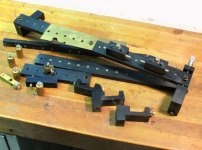I must confess; rather than working hard and earning a honest dollar, I often waste too much time on fun projects. For many years one was ornamental turning. Since I could not afford to buy a Holtzapffel ornamental turning lathe, I decided to build a humble machine with some of the capabilities. I bough a used EMCO Maximat 7 (just about the right size for small work and actually a very decent small lathe) as the starting step, and continued for the next 40 years adapting it to ornamental turning and making many of the accessories needed for this embarrassing hobby.
One often required feature is a long, slow, multiple start helix; way beyond the range of regular thread cutting. For this I replaced one of the change gears with a rotary gearbox. This can be engaged in 12 positions on its periphery, giving 12 ratios of up to 1:42,000. For this type of steep helix, the normal order of things is reversed and the headstock is rotated through the gearbox by a handle on the lead-screw.


One often required feature is a long, slow, multiple start helix; way beyond the range of regular thread cutting. For this I replaced one of the change gears with a rotary gearbox. This can be engaged in 12 positions on its periphery, giving 12 ratios of up to 1:42,000. For this type of steep helix, the normal order of things is reversed and the headstock is rotated through the gearbox by a handle on the lead-screw.









